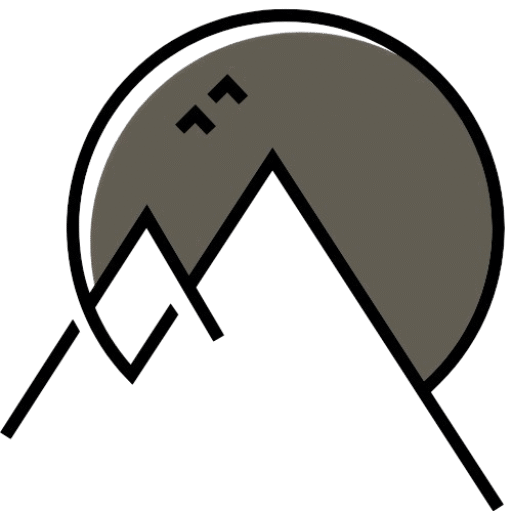Hunza Valley is my favorite place on earth—bold statement, I know, but hear me out. Tucked deep in Gilgit-Baltistan, Pakistan, this high-altitude paradise is surrounded by snow-capped peaks, turquoise lakes, and ancient forts that whisper stories of the past.
Unlike many parts of Pakistan, women here walk freely, run businesses, and are deeply integrated into daily life. The valley has a near zero crime rate, and street harassment—an unfortunate reality everywhere else in Pakistan—is virtually unheard of. Add to that the legendary hospitality, organic food, and a perfect mix of adventure and history, and you have a destination that’s impossible to forget.
But with tourism on the rise, it’s easy to get caught up in the same Instagram-famous spots and miss out on what makes Hunza truly magical. After a dozen visits since 2014, I’ve put together a list of 21 things to do in Hunza Valley—a mix of must-sees and hidden gems—to help you experience it in the most authentic way possible.
About Hunza
Hunza is divided into three regions: Lower Hunza, where the Hunza River carves through rugged valleys; Central Hunza, home to historic forts and the main town, Karimabad; and Upper Hunza (Gojal), a high-altitude region leading to Khunjerab Pass. Towering above it all are some of the world’s highest peaks, including Rakaposhi (7,788m), Ultar Sar (7,388m), and Ladyfinger Peak (6,000m), their snow-covered summits visible from nearly every corner of Hunza.
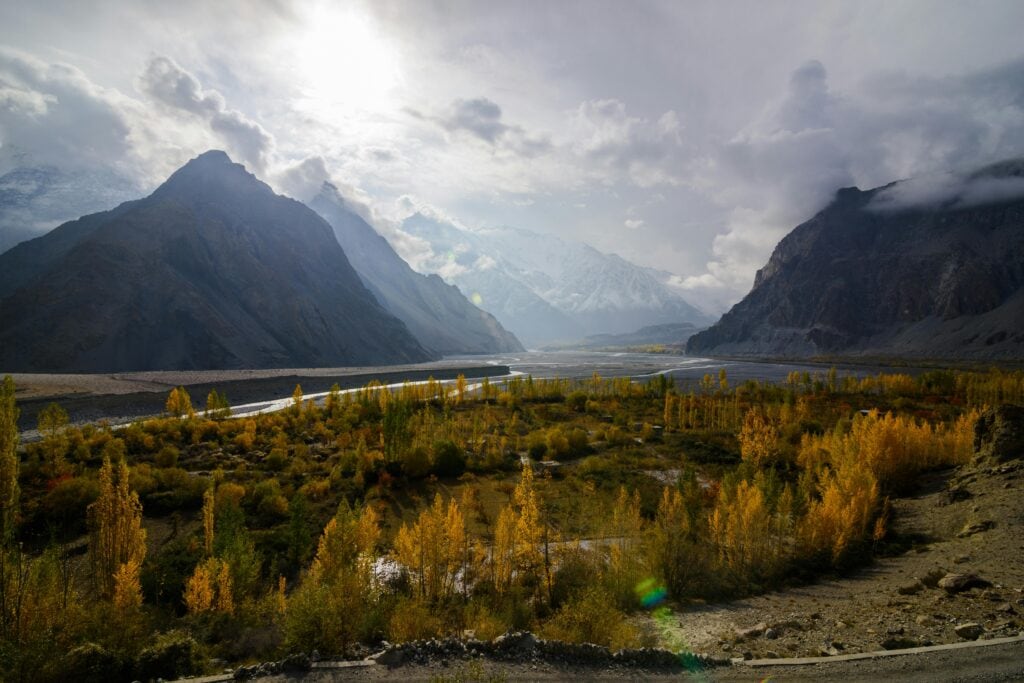
1. Hike Up to the Forts – Baltit and Altit
If you’re in Hunza, you’re hiking up to Baltit and Altit Forts—no debate. These two centuries-old structures sit on the hills above Karimabad, and if you’re even remotely interested in history, culture, or just getting insane panoramic views, they’re well worth the climb.
The forts were built to protect Hunza’s rulers, keep an eye on trade routes, and (let’s be real) show off a little. They’ve both been carefully restored, and with a guided tour, you’ll get a solid history lesson—minus the boring textbook feel.
Baltit Fort
Baltit Fort is the one you’ve probably seen in all the Hunza photos. It’s perched right above Karimabad, and with its Tibetan-style wooden balconies, it looks straight out of a fantasy novel. Built over 700 years ago, it was once home to the Mirs of Hunza—aka the valley’s rulers—who strategically placed it overlooking the old Silk Road.
Inside, you’ll walk through dimly lit hallways, rooms filled with old weapons, and even a secret escape tunnel (because every good fort needs one). A guided tour makes a huge difference here—they’ll explain why the rulers abandoned Baltit for Altit, what alliances were formed here, and the role the fort played in battles. Plus, the rooftop views of Rakaposhi and Diran Peak are a bonus.
Opening Hours | 9 AM – 5 PM (Daily)
Entry Fee | PKR 1200 (Foreigners) | PKR 600 (Locals)
Best Time to Visit | Early morning for peace and quiet, or late afternoon for that golden-hour glow
How to Get There | It’s a 15–20 minute steep walk from Karimabad Bazaar.
Altit Fort
Altit Fort doesn’t get as much hype as Baltit, but it’s older, grittier, and arguably cooler. Built over 900 years ago, this was Hunza’s original royal residence, strategically positioned to spot invading forces long before they got close. It’s a stark contrast to Baltit’s elegance—Altit is all thick stone walls, narrow corridors, and a much more practical, no-frills design.
One of the fort’s most infamous spots? The execution rock. Back in the day, criminals (or just unlucky people) were shoved off the edge as punishment. The guides will casually point it out—try not to stand too close.
Right outside the fort is the Royal Garden, an unexpectedly peaceful place with terraced apricot orchards and shaded seating areas. If you visit in spring (March–April), the entire area is covered in pink and white apricot blossoms—easily one of the most beautiful spots in Hunza.
There is now an option to stay in this 11th Century fort, Serena Altit Fort Residence located in what used to be the Royal Gardens of the fort. I personally haven’t stayed here myself, it’s kind of out of budget for me. But also on the list, maybe when this blog takes off? Haha.
Hunza’s forts are just the beginning—if you’re a history buff, don’t miss this guide to historical places in Pakistan.
Opening Hours | 9 AM – 5 PM (Daily)
Entry Fee | PKR 1200 (Foreigners) | PKR 600 (Locals)
Best Time to Visit: Early morning or late afternoon
How to Get There | A short walk down from Baltit Fort or a direct route from Karimabad Bazaar
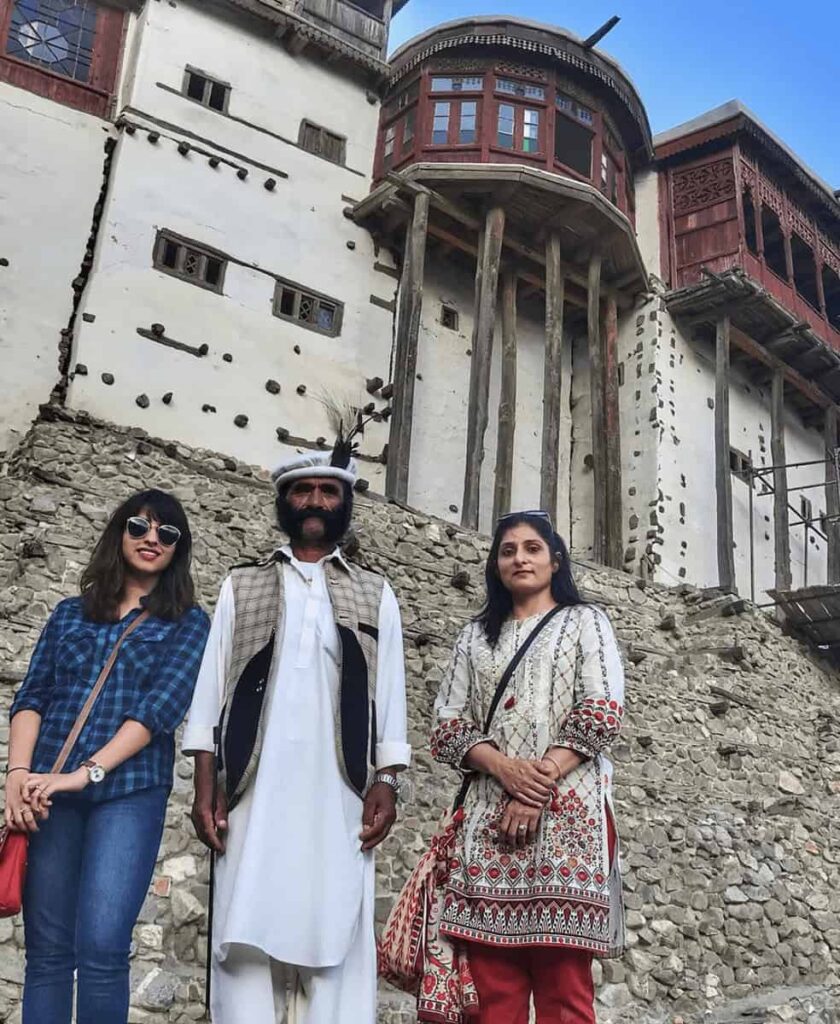
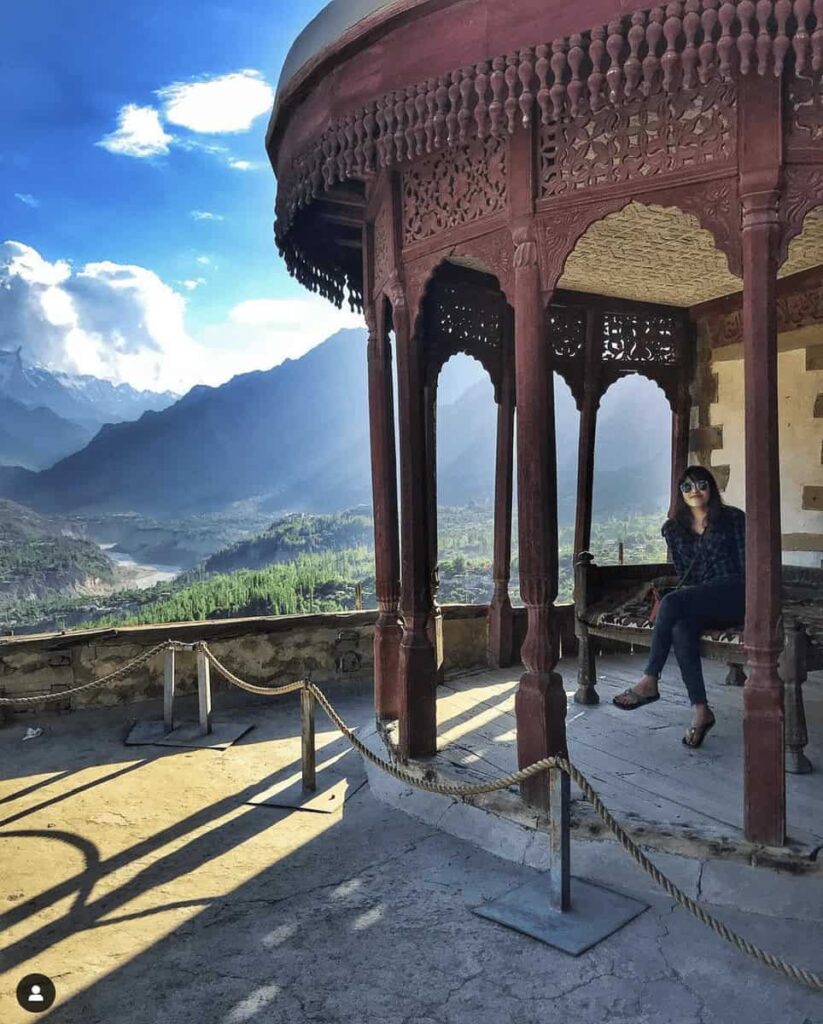
2. Visit Borith Lake
Borith Lake sits at 2,600 meters in Upper Hunza, near Gulmit. It’s a saltwater lake fed by glacial melt, with stunning reflections of the surrounding peaks.
Getting there is easy. A jeep track leads from Hussaini village, or you can trek up from Gulmit—a scenic but steep climb. The lake is a popular stop for birdwatchers in spring and autumn when migratory birds, including ducks, pass through.
I once camped here in winter, and let’s just say I still have mild PTSD from the experience. Zero degrees, fierce winds, and a thin sleeping bag—bad decisions were made. But if you’re not stupid like me, Borith is a great spot to relax, picnic, or even take a short trek toward Passu Glacier for even better views.
3. Explore Gulmit
Gulmit is the heart of Upper Hunza, about 30 minutes from Karimabad. It’s a quiet, traditional Wakhi village surrounded by towering peaks, apricot orchards, and ancient ruins.
I visited with one of my guides, who made us stay in his family’s home. Easily some of the nicest people I’ve ever met—genuine, warm, and endlessly hospitable.
Walk through the narrow village paths, visit the Gulmit Museum, and check out the wooden Wakhi houses that have stood for centuries. There’s also a small hike up to Ondra Fort, with a killer view of Attabad Lake and the Passu Cones.
4. Cross Hussaini Suspension Bridge
The Hussaini Suspension Bridge connects the villages of Hussaini and Zarabad over the Hunza River. It looks like something out of an adventure movie—rickety wooden planks, wild winds, and a serious drop below.
It’s famous now, but locals actually use it daily to get to their fields and homes. It’s not just for tourists. If you’re up for the challenge, crossing it is a thrill. If not, watching others attempt it is entertainment enough.
Nearby, you’ll find Borith Lake, the Passu Glacier trek, and some of the best views of the Passu Cones. Perfect for a quick stop or a full day of exploring.
5. Ride a Motorbike Along the Karakoram Highway
The Karakoram Highway (KKH)—dubbed the “Eighth Wonder of the World”—is a road trip like no other. It snakes through Hunza’s towering peaks, past glacial rivers, and into high-altitude deserts, connecting Pakistan to China at Khunjerab Pass.
Renting a motorbike in Karimabad costs around PKR 1,500 per day, giving you the freedom to stop anywhere, take in the views, and explore villages along the way. I didn’t ride myself, but sitting on the back of a friend’s bike gave me the perfect front-row seat to Hunza’s landscapes—lakes, glaciers, and the surreal sight of mountain goats casually navigating cliffs.
6. Visit Khunjerab Pass
At 4,693 meters (15,397 feet), Khunjerab Pass is the highest paved border crossing in the world, where Pakistan meets China. It’s an impressive feat of engineering, but let’s be real—it’s also a long journey.
The drive takes 4–5 hours each way from Hunza, winding through Khunjerab National Park, where you might spot ibex, markhors, or even a snow leopard if you’re ridiculously lucky. That said, it’s 10 hours in a car just to take a photo at a border post. If you’ve got extra time, go for it. If not, there are way better ways to spend a day in Hunza.
Pro tip: If you do make the trip, bring warm layers—even in summer, temperatures at the top can drop below freezing.
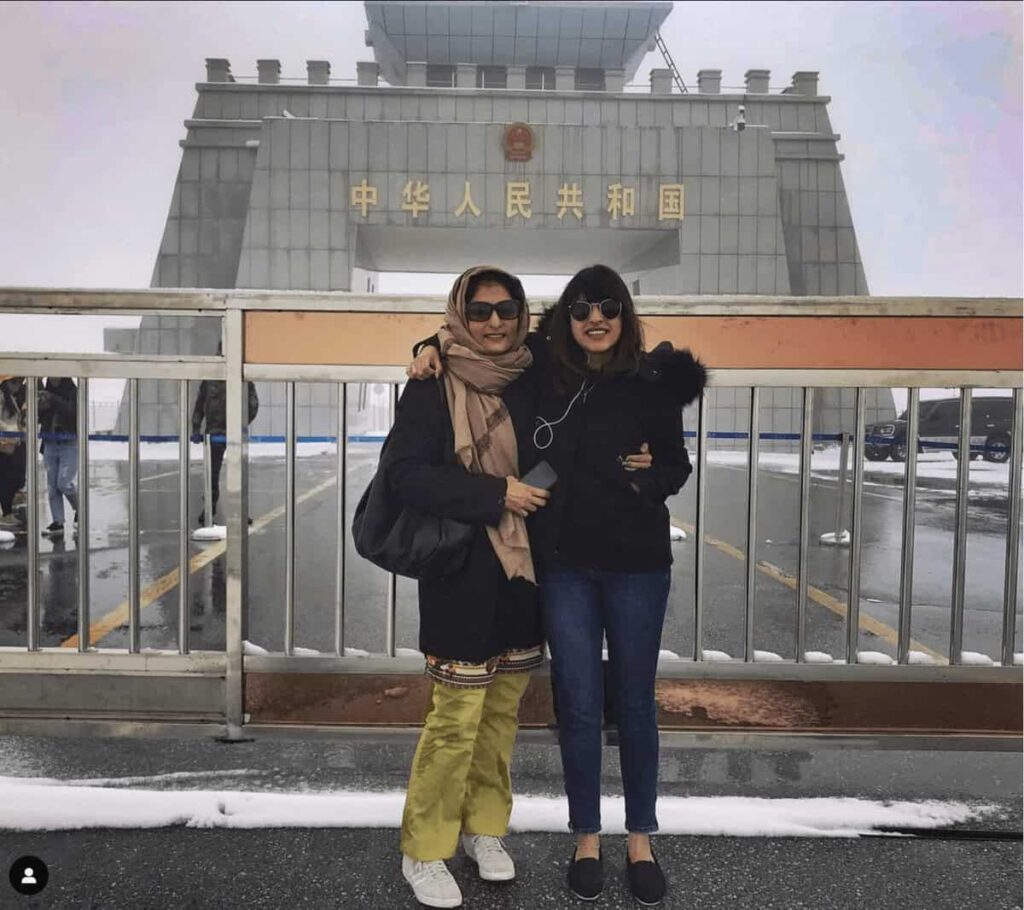
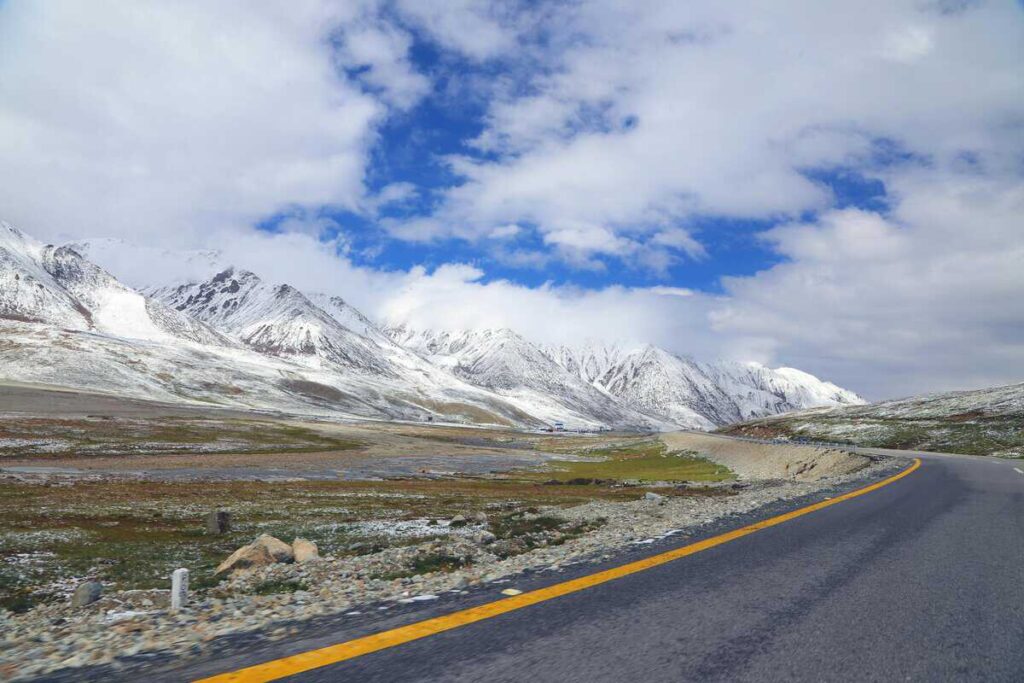
7. Trek to Rakaposhi Base Camp
You see Rakaposhi (7,788m) from almost anywhere in Hunza, but if you really want to experience its sheer scale, trekking to its base camp is the way to do it.
It’s a steep but doable trek, and you don’t need a guide if you’re used to hiking. The first half is a relatively easy walk through alpine meadows, but the final stretch is a grueling ascent—worth it for the front-row view of Rakaposhi’s massive ice walls.
Camping overnight at Taghafari Base Camp is an option, but if you’re short on time, you can make it a long day hike. Either way, expect sore legs and unforgettable views.
Trailhead | Minapin village
Distance | ~12 km
Elevation Gain | ~1,500m
Base Camp Altitude | 3,700m (Taghafari)
Time Required: 6-8 hours one way
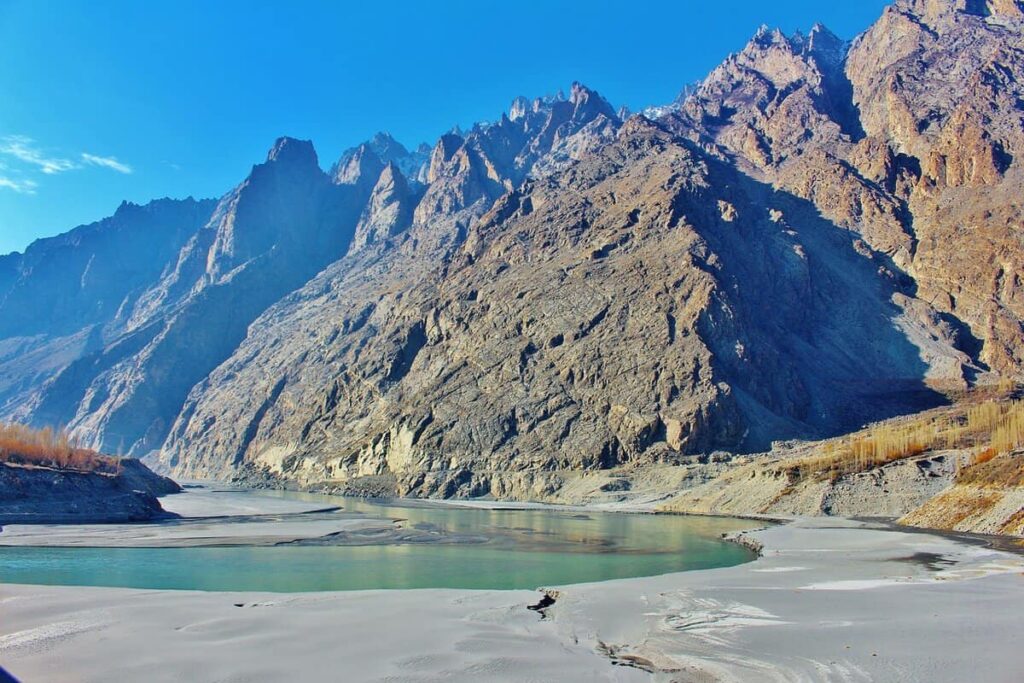
8. Discover Ganish Old Village
Ganish is the oldest settlement in Hunza, over 1,000 years old, and once an important stop on the ancient Silk Road. It’s a place where time stands still—narrow alleys, traditional wooden houses, and four mosques over 300 years old that are still standing today.
Unlike the polished tourist spots in Hunza, Ganish feels raw and lived-in. Walking through the village, you’ll see centuries-old water channels, communal spaces, and storage rooms once used for aging butter (yes, really). The site has even received UNESCO recognition for its conservation.
A local guide is the best way to experience Ganish. They’ll walk you through the village’s history, its unique Wakhi and Burusho traditions, and the fort-like watchtowers that once protected it from invaders. If you want a glimpse of Hunza before modern roads and tourism, this is it.
9. Explore Attabad Lake
Attabad Lake is breathtaking, but bittersweet. Back in 2010, a massive landslide buried villages, blocked the Hunza River, and created this lake overnight. Today, it’s one of Hunza’s biggest attractions, with its electric-blue water stretching between cliffs.
It’s no secret that Attabad can get crowded, with speedboats, jet skis, and cafes lining the shore. But it still has its moments—early mornings are peaceful, and if you’re up for it, a short hike up the cliffs gives you a panoramic view without the noise.
For all its beauty, Attabad is also a reminder of nature’s power—a stunning landscape that exists only because entire villages were lost beneath it.
10. Savor the Local Food Scene
Hunza’s food scene isn’t flashy, but it’s comforting, homey, and deeply tied to the land. Meals here are simple, organic, and built for the cold mountain air.
- Mamtu – Steamed dumplings stuffed with spiced meat and onions. Try them at Muliaan’s Kitchen, a woman-run spot in Karimabad that keeps Hunza’s flavors alive.
- Chapshuro – Hunza’s take on a meat pie, filled with minced yak or beef, baked in a tandoor.
- Walnut Cake – Café de Hunza’s version is famous, best paired with their strong coffee and a mountain view.
- Apricot Products – Apricot jam, dried apricots, and even apricot oil—Hunza’s staple fruit shows up in everything.
For a wider variety of traditional dishes, head to Hunza Food Pavilion, where you’ll find thick soups, handmade breads, and seasonal specialties straight from the valley’s farms.

11. Hike to Ultar Base Camp
Ultar Sar (7,388m) looms over Hunza, and trekking to its base camp is one of the toughest—but most rewarding—hikes in the valley.
The trail starts in Karimabad, passing through Shahabad and Shamir Harai before reaching Bath Bakhor, where the real challenge begins. It’s a steep climb, with sections of loose rock and exposed ridges, but the views of Hunza Valley and Ladyfinger Peak make every step worth it.
The final stretch leads into a wild, glacial valley, surrounded by sheer rock faces and snow-covered peaks. It’s not for beginners, but if you’ve got the stamina, camping here under the stars is unreal.
Best time to go? Late spring to early fall, when the trails are clear, and the weather is (mostly) stable.
Trailhead | Karimabad
Distance | ~10 km
Elevation Gain | ~1,500m
Base Camp Altitude | ~4,100m
Time Required | 6-8 hours one way
12. Go River Rafting in Hunza River
If you want adventure with a view, rafting down the Hunza River is the way to go. The glacier-fed water is icy and fast, making for a thrilling ride as you navigate the rapids with massive peaks towering around you.
Most rafting trips start near Gilgit or Karimabad, with beginner-friendly rapids that still pack a punch. Summer (May to September) is the best time when the river is at its strongest. While I haven’t ticked this off my list yet, it’s only a matter of time.
Where to book? There are a few local operators in Karimabad and Gilgit that run trips—just ask around when you arrive.
13. Watch a Freestyle Polo Match
Polo in Hunza is nothing like the polished version you see on TV—this is raw, untamed, and played at full speed with zero rules. It’s known as the “Polo of Kings”, but here, it’s a game of grit, pride, and serious skill.
You don’t have to wait for the Shandur Polo Festival to catch a match. Aliabad and Karimabad Polo Grounds host games throughout the year, especially during festivals like Jashn-e-Baharan (Spring Festival) and Ginani (Harvest Festival).
If you’ve never seen freestyle polo before, expect chaos on horseback, intense rivalries, and crowds that get just as into it as the players.
14. Watch locals play cricket by the Passu Cones
I wasn’t expecting to find a cricket match in the middle of the mountains, but while staying in Passu, I stumbled onto one of the coolest games I’ve ever seen.
There’s no official stadium—just an open field, a makeshift pitch, and the jagged Passu Cones looming in the background. The players were locals, the game was intense, and the vibe was unreal.
If you’re in Passu, keep an eye out in the evenings or weekends—locals gather for casual matches, and they won’t mind if you jump in for a few overs. Just don’t expect a flat wicket.
15. Experience Cherry Picking in Hunza
If you’re in Hunza between May and early July, cherry picking is a must. The valley’s cherries are small, sweet, and packed with flavor, and picking them straight from the orchards beats any store-bought version.
Farmers in Karimabad, Aliabad, and Gulmit often let visitors pick cherries for a small fee—or sometimes for free if you ask nicely. Some guesthouses and homestays even have their own orchards, meaning you can literally grab breakfast off a tree.
Expect to pay around PKR 200–500 per kg if you’re taking some home. Wear good shoes, since you’ll be walking through farms and maybe climbing a few trees.
16. Join a Traditional Hunza Festival
Festivals in Hunza aren’t just events—they’re loud, vibrant, and a full-blown community celebration. Whether it’s the Spring Blossom Festival, when the valley turns pink and white with apricot blossoms, or Ginani, marking the start of the harvest, these festivals bring music, dance, and local traditions to life.
The best part? You don’t just watch—you join in. Locals will pull you into traditional dances, offer you plates of home-cooked food, and treat you like you belong. If you’re in Hunza during festival season, don’t just stand on the sidelines—jump in.
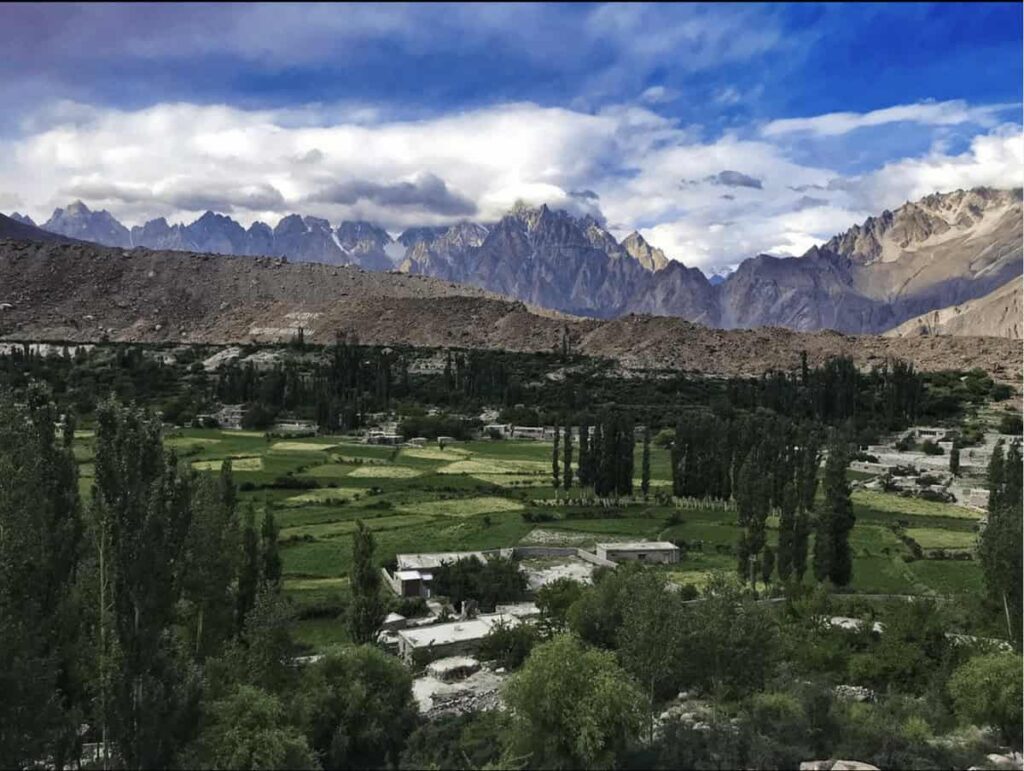
17. Walk on a Glacier
Walking on a glacier in Hunza doesn’t require an expedition team or climbing permits—just a bit of effort and the right spot.
Ghulkin Glacier, near Ghulkin village, is the most accessible, but it’s mostly rock-covered these days. If you want actual ice, head to Passu Glacier, reachable via a short hike from Borith Lake Zero Point.
For something more remote, Batura Glacier stretches 57 km, making it one of the longest in the world. If you’re up for an overnight trek, the experience is next level—nothing but ice, rock, and the sound of distant avalanches.
Tip | Glaciers shift. Walk carefully, and don’t go alone unless you know what you’re doing.
18. Try Hunza Water (at your own risk)
Hunza Water isn’t what it sounds like. It’s local homemade moonshine, brewed from grapes, mulberries, apples, or apricots. Despite Pakistan’s strict alcohol laws, if you know where to look, you’ll probably stumble across it in Hunza.
Locals have been making it for centuries, and while it’s smooth, it’s stronger than it looks. If you’re curious enough to try, find a trustworthy local—the good stuff is home-brewed, not mass-produced. Just know your limits—Hunza Water hits hard.
19. See Nanga Parbat and the Meeting Point of Three Mountain Ranges
Driving up the Karakoram Highway, there are two unmissable roadside stops |
- Nanga Parbat Viewpoint – At 8,126 meters, this is the 9th highest mountain in the world, nicknamed the “Killer Mountain” for its deadly climbing history. You don’t need to trek to its base camp—even from a distance, it’s massive and awe-inspiring.
- Confluence of Three Mountain Ranges – The exact point where the Karakoram, Hindu Kush, and Himalayan ranges meet. The view is raw, rugged, and unreal—perfect for a quick photo stop before heading further into Hunza.
Both are easy stops, right off the highway—no detours required.
20. Buy Souvenirs at Karimabad Bazaar
If you’re taking something home from Hunza, Karimabad Bazaar is the place to shop. Lining the steep streets that wind up toward Baltit Fort, this market is packed with locally made handicrafts, gemstones, and traditional clothing. The best finds? Hunza’s famous gemstones like aquamarine, topaz, and ruby, though you’ll need to bargain smartly. Woolen shawls and handmade rugs are also worth picking up, especially the yak wool ones, which are lightweight yet incredibly warm.
A traditional Hunza cap makes for a classic souvenir, and if you’re after something edible, dried apricots and walnuts are a must—Hunza’s signature snack, perfect for gifts or road trip fuel. Skip the mass-produced touristy trinkets and go for the real, locally crafted stuff—the vendors here are friendly and always happy to chat about their work.
21. Explore Hopar Valley
Just 30 km from Karimabad, Hopar Valley is where you go to escape the crowds. The drive itself is half the adventure, with winding mountain roads leading to one of Hunza’s most peaceful and underrated spots. Once you arrive, Hopar feels like a world of its own—quiet meadows, traditional stone houses, and locals who welcome you with warm smiles. The Baltura Glacier is one of the main highlights here, accessible via a short trek from the village. It’s a lot less touristy than Passu Glacier, making for a more raw and immersive experience. Beyond the glacier, the valley is perfect for slow walks, soaking in the scenery, and just experiencing Hunza at a different pace. If you’re looking for a break from the more crowded spots, Hopar Valley is worth the detour.
Where To Stay In Hunza
Hunza offers a range of accommodations to suit different budgets. Here are some of my recommendations:
Luxury | Serena Alti Fort. With its manicured gardens, unbeatable views, and top-notch service, this is where you treat yourself.
Mid-range | Old Hunza In. Centrally located in Karimabad, this is a reliable and comfortable option.
Essential Travel Tips for Visiting Hunza
Getting to Hunza
The most common way to reach Hunza is via the Karakoram Highway (KKH) from Islamabad, a 20-24 hour drive that’s best split over two days with a stop in Naran (summer) or Besham (year-round). If you want to skip the long road journey, flights to Gilgit are available, but delays due to weather are common. From Gilgit, Hunza is just a 2-3 hour drive.
Getting Around
- Public Transport: Shared vans (called Hiace) run between towns, but schedules are unreliable.
- Private Car with Driver: Costs PKR 10,000 per day but makes remote areas more accessible.
- Motorbike Rental: PKR 1,500 per day, great for exploring at your own pace.
Connectivity & Local SIMs
Hunza’s WiFi is hit or miss, and only Telenor and SCOM SIMs work decently. Even then, expect slow speeds. Download offline maps before arriving.
Cultural Norms & Local Etiquette
Hunza is predominantly Ismaili Muslim, known for its openness and hospitality. Women travelers will find dress codes more relaxed here than in other parts of Pakistan, but covering shoulders and legs is still recommended out of respect. Learning a few words in Burushaski or Wakhi goes a long way!
What’s Next After Hunza?
Hunza has a lot to offer—stunning landscapes, rich history, and some of the warmest people you’ll meet. Whether you’re hiking to base camps, crossing sketchy suspension bridges, or just eating your weight in apricots, this valley never disappoints.
If you’re planning to explore more of Northern Pakistan, don’t stop here. Check out my Gilgit Baltistan itinerary – a detailed route, travel tips, and must-visit spots beyond Hunza.
Frequently Asked Questions
What is the best time to visit Hunza Valley?
The best time to visit Hunza Valley is April to October. Spring turns the valley pink with apricot blossoms, summer is prime trekking season, and autumn is stunning with golden foliage. Winter is harsh and best avoided unless you’re here for snow and solitude.
What is the daily budget for a trip to Hunza?
Your daily budget in Hunza depends on how you travel. Budget travelers can get by on PKR 5,000-10,000 per day, while mid-range travelers should expect PKR 15,000-20,000 per day. Accommodation ranges from PKR 7,000-20,000 per night, meals cost PKR 1000-2,000, and a car with a driver is around PKR 10,000 per day. Motorbike rentals go for about PKR 1,500 per day, and treks may have extra guide and gear costs.
How safe is Hunza for tourists?
Hunza is one of the safest places in Pakistan. Crime is practically nonexistent, and the locals are incredibly welcoming. Women travelers, including foreigners, find it much more comfortable than many other parts of the country, with relaxed dress codes and a strong sense of community safety.
Is a permit required for foreigners to visit Hunza?
No permit is required for foreigners to visit Hunza, except if you’re planning to go near the China border, in which case you may need special permission.
Can you visit Hunza in winter?
Yes, but only if you’re ready for harsh cold, snow-blocked roads, and limited activities. If you’re after adventure, consider skiing in Naltar instead, which is a better winter destination.
Related Posts
- Best Hotels in Lahore: Where to stay Guide from a Local
- A Guide For Planning Your First Trip To Pakistan
- Pakistan Itinerary: A Local’s Guide to 2 Weeks in Pakistan
- 17 Historical Places of Pakistan: Lost Temples, and Epic Forts
- 17 Cool Things to Do in Islamabad: A Local’s Guide
- Is Pakistan Safe for Women to Travel (An Honest, No-BS Guide)
